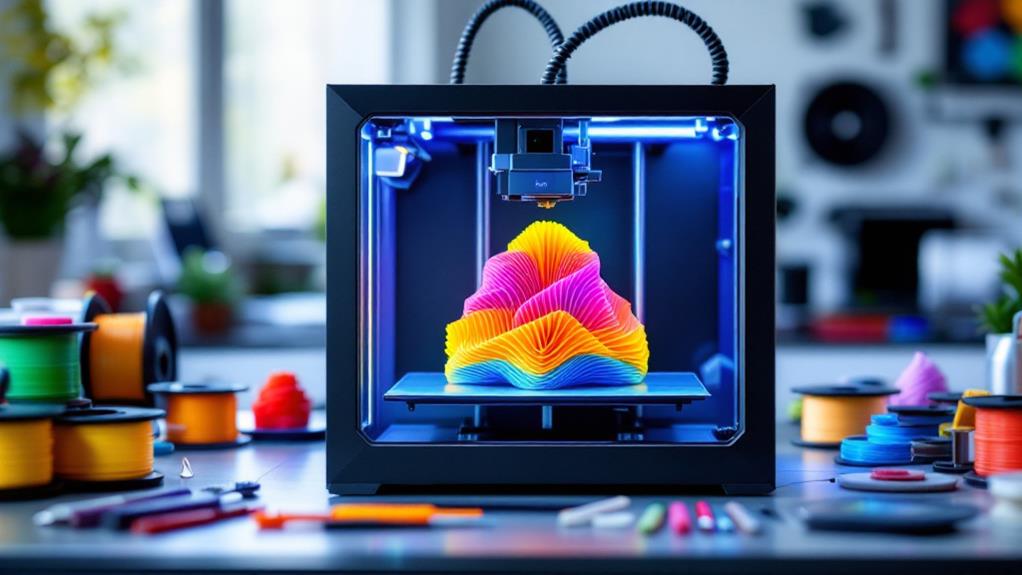What Is an Atomic Clock and Why Is It Important?

An atomic clock uses the precise oscillation frequencies of atoms, like cesium or rubidium, to measure time accurately to within a billionth of a second. This precision is vital for technologies you rely on daily, such as GPS navigation, where timing errors could lead to significant inaccuracies in location data. Atomic clocks guarantee seamless communication by providing fundamental time synchronization across telecommunication networks. They also play a key role in scientific research, space exploration, and even secure banking transactions. By understanding more about atomic clocks, you'll see how they quietly influence numerous facets of modern life.
Understanding Atomic Clocks
Though the concept might seem complex initially, understanding atomic clocks isn't as intimidating as it sounds. At their core, atomic clocks rely on quantum mechanics, a branch of physics that explains the behavior of matter and energy at microscopic scales. Unlike traditional clocks that use mechanical movements or quartz vibrations, atomic clocks measure time by observing the vibrations of atoms. Specifically, cesium or rubidium atoms are commonly used because of their consistent oscillation frequencies.
Imagine trying to measure time using a pendulum that swings with incredible precision. Atomic clocks do something similar but on an atomic level. The oscillations of these atoms are incredibly stable and precise, making them ideal for time measurement. They're so accurate that they can keep time to within a billionth of a second.
When you explore quantum mechanics, you start to see how these atomic vibrations provide an ultra-precise timekeeping standard. This precision is essential for a range of applications, from GPS navigation to scientific research. By grasping the basics of atomic clocks, you're tapping into a powerful tool that defines our modern understanding of time measurement, guided by the principles of quantum mechanics.
How Atomic Clocks Work
When you engage yourself in how atomic clocks work, you'll find it's all about harnessing the reliability of atomic vibrations. At the heart of an atomic clock, quantum mechanics plays a vital role. Atoms, particularly cesium or rubidium, vibrate at incredibly precise frequencies when exposed to specific electromagnetic fields. These vibrations aren't random; they're dictated by the energy levels defined by quantum mechanics.
You'll see that these atomic vibrations serve as dependable frequency standards. Fundamentally, the process involves tuning a microwave oscillator to match the atom's natural frequency. This tuning is achieved through a feedback loop that constantly adjusts the oscillator to stay in sync with the atom's vibrations. The result is an unparalleled level of timing accuracy.
The reliability of these vibrations allows atomic clocks to outperform any mechanical clocks. You might find it fascinating that an atomic clock can lose less than a second over millions of years. This precision is critical for technologies like GPS and global communication networks, where even the tiniest timing error can lead to significant discrepancies. Understanding how atomic clocks work gives you insight into why they are indispensable in modern technology.
Types of Atomic Clocks

Atomic clocks come in diverse types, each utilizing different atomic elements and mechanisms to achieve precise timekeeping. The cesium standard is the most widely recognized type and forms the basis for defining the second in the International System of Units. It uses the microwave frequency emitted by cesium atoms, achieving remarkable precision measurement. Laser cooling techniques improve its stability by reducing thermal motion, allowing for even more accurate frequency standards.
Another intriguing type is the hydrogen maser, which operates on the principles of quantum coherence. It offers exceptional short-term stability, making it ideal for applications requiring rapid precision. However, it demands regular maintenance to maintain its accuracy over time.
Optical lattice clocks represent the forefront of atomic clock technology. They trap atoms in a grid of laser light, effectively using time dilation effects predicted by Einstein's theory of relativity to refine measurements. This creative approach offers significant advancements in precision measurement.
Each type of atomic clock serves a unique purpose, regardless of in scientific research, telecommunications, or global positioning systems. Understanding these different types and their underlying mechanisms helps you appreciate the critical role atomic clocks play in modern technology, ensuring unparalleled accuracy in timekeeping.
History of Atomic Clocks
The expedition of atomic clocks began in the mid-20th century, transforming how we measure time. It all started with the groundbreaking work of notable inventors like Louis Essen and Jack Parry, who built the initial practical atomic clock in 1955. Their creation marked a key milestone, improving timekeeping accuracy exponentially. This innovation paved the way for advancements in science and technology, as these clocks became the standard for precise time measurement.
Another crucial moment occurred in the 1960s when scientists developed cesium-based atomic clocks. This led to the redefinition of the second in 1967, based on the vibrations of cesium atoms. These advancements didn't just tweak timekeeping; they changed it fundamentally, enabling technologies like GPS to flourish.
Atomic clocks continue to evolve, with optical lattice clocks and hydrogen maser clocks pushing the boundaries of precision. Each new development contributes to our understanding of time and its applications in diverse fields. As you ponder these achievements, consider the emotional impact of such progress:
- Awe at the precision and complexity of human innovation.
- Gratitude for the scientists who shaped modern timekeeping.
- Hope for future breakthroughs that redefine our perception of time.
Atomic Clocks vs. Traditional Clocks

Imagine comparing two types of clocks: traditional mechanical ones and advanced atomic clocks. Traditional clocks, like pendulum or quartz watches, rely on mechanical movements or electronic oscillations. They're familiar and have served us well for centuries. However, they lack the precision measurement capabilities of atomic clocks. Atomic clocks use the vibrations of atoms, typically cesium or rubidium, to keep time with incredible accuracy. This method allows them to maintain time down to billionths of a second.
When it comes to time synchronization, atomic clocks are unrivaled. Synchronizing time across the globe is essential for many technologies and systems. While traditional clocks can drift by seconds over days or weeks, atomic clocks might only lose a second in millions of years. This reliability guarantees that systems relying on synchronized time, such as telecommunications networks and financial markets, function smoothly and efficiently.
Role in GPS Technology
With their unparalleled accuracy, atomic clocks play a critical role in GPS technology. Imagine trying to pinpoint your exact location on Earth; it wouldn't be possible without precise time measurements. GPS satellites rely on atomic clocks for satellite synchronization, guaranteeing they operate in harmony. The slightest error in timing could lead to significant errors in location data—sometimes off by miles! When you use your phone's GPS to navigate, you're benefiting from the time accuracy provided by these clocks, as they help calculate your position by measuring the time it takes for signals to travel from satellites to your device.
Consider the emotional impact of these precise clocks:
- 🌍 Never getting lost: Thanks to atomic clocks, you can confidently discover new places without fear of losing your way.
- 🚑 Emergency response: Accurate GPS allows primary responders to reach emergencies faster, potentially saving lives.
- 🌐 Global connection: You're able to connect with others worldwide, knowing your location services are reliable.
Atomic clocks guarantee that GPS technology remains accurate and dependable, providing you with precise navigation and enhancing your experiences. Accept the confidence and safety that come with knowing your position is always spot on.
Impact on Telecommunications

In the current interconnected world, telecommunications' reliance on atomic clocks guarantees seamless and efficient communication. You might not realize it, but every call you make and every video you stream depends on the frequency stability and timekeeping precision of atomic clocks. These clocks guarantee synchronization accuracy, allowing networks to maintain precise signal timing. This synchronization is vital for network synchronization, which keeps all components of a telecommunications system in perfect harmony.
When you send a message or access the internet, data transmission relies heavily on atomic clocks. They provide the precise timing needed to reduce latency and improve system reliability. Without these clocks, you'd experience delays and disruptions, making it hard to maintain smooth communication. The exact timing of data packets guarantees they arrive in the correct order, minimizing errors and preserving the quality of your communication experience.
Furthermore, atomic clocks help in latency reduction, crucial for time-sensitive applications like video conferencing and online gaming, where even a slight delay could cause significant disruptions. By maintaining the highest standards of synchronization accuracy and frequency stability, atomic clocks play a fundamental role in guaranteeing that your telecommunications experiences are consistently reliable and efficient.
Contribution to Scientific Research
Atomic clocks are essential tools in scientific research, providing unmatched precision in time measurement that underpins numerous complex studies. When you're involved in research that requires minute accuracy, atomic clocks become indispensable. They offer precision measurement that guarantees your experiments and data collection are impeccable. Think about how scientists study phenomena like gravitational waves or test the fundamental laws of physics; atomic clocks keep everything precisely synchronized.
Consider the impact of atomic clocks on:
- Space Exploration: They help navigate spacecraft through the vastness of space, making sure every move is perfectly timed.
- Climate Science: Accurate timekeeping allows for precise data collection in studying climate patterns and changes.
- Fundamental Physics: Testing theories such as relativity relies heavily on time synchronization provided by atomic clocks.
Their role in time synchronization is essential for maintaining the integrity of your scientific data. Without this synchronization, you'd face discrepancies and inaccuracies that could derail your findings. Atomic clocks help unify global research efforts by providing a common time standard, eliminating time-based inconsistencies across different labs and locations. When you rely on such exactitude, atomic clocks empower you to push the boundaries of exploration and innovation in ways that were once unimaginable.
Influence on Everyday Life

Beyond their vital role in scientific research, atomic clocks greatly impact your everyday life, even if you don't realize it. These clocks guarantee time synchronization across diverse technologies you depend on. From your smartphone to financial transactions, atomic clocks provide the precision timing necessary for smooth operations. Think about global positioning systems (GPS) you use for navigation. They rely on atomic clocks for scientific accuracy, allowing you to find your way with ease.
Atomic clocks have paved the way for technological advancements that permeate daily applications. When you make a phone call or send a message, communication networks depend on precise timing to function seamlessly. This precision guarantees your messages don't get lost or delayed, keeping you connected to the world.
In banking, atomic clocks facilitate secure transactions by providing the exact timestamps needed for verifying and completing financial operations. This level of accuracy prevents errors and fraud, giving you peace of mind.
These clocks also play a role in power grids, guaranteeing electricity is distributed efficiently and reliably. Essentially, atomic clocks are the unseen backbone of many systems you use daily, making modern life more convenient and interconnected.
Future Developments in Atomic Clocks
Looking to the future, atomic clocks promise even greater precision and versatility in different fields. They're set to revolutionize how you interact with technology and understand the universe. One exciting development is quantum synchronization, which could synchronize devices with unprecedented accuracy. Imagine your GPS directing you with pinpoint precision, or financial systems executing transactions with flawless timing. These advancements aren't just about being on time—they're about revealing new possibilities.
Precision advancements mean atomic clocks will become even more accurate, potentially redefining time itself. This could lead to breakthroughs in scientific research, enabling you to investigate phenomena like gravitational waves or dark matter with improved clarity. The dream of examining the universe more deeply is within reach.
Consider the emotional impact these developments could have:
- Awe: Marvel at the universe's mysteries being unraveled with newfound clarity.
- Excitement: Anticipate a future where technology seamlessly integrates with your daily life, making it more efficient and connected.
- Hope: Envision a world where scientific discoveries lead to solutions for global challenges.
These future developments in atomic clocks hold the potential to transform your world, offering exciting opportunities and profound impacts across different fields.



